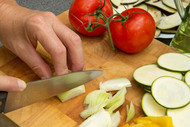Why is Maple the Most Popular Wood for Cutting Boards?
Posted by Grant Chen on 17th Oct 2024

The Most Popular Wood for Your Kitchen
Whether you’re outfitting a professional workspace, or simply finishing off your gourmet roost at home, having a solid and reliable cutting surface is a must. Gratefully there are many options when shopping for the perfect cutting board for your kitchen. Wood, plastic, and composite all offer their own unique advantages; the trick is narrowing down what’s right for you. Though each surface may have its own particular value, it is believed that wooden cutting boards and blocks provide the best life for your knives, and are also a safe and sturdy option for your food preparation areas.
If you’ve decided on a wood cutting board, you’ve made a good choice. Wooden boards come in many varieties including but not limited to maple, pecan, walnut, teak and cherry. Maple is by far, the most popular wood option on the market – and for good reason. This native tree species can be used to create a hard work surface in the kitchen, and is a reliable and renewable resource.
Abundantly North American
Hard Rock Maple, also known as Sugar Maple, is found in abundance throughout the upper Midwest and Canada. Its range is from Nova Scotia to Ontario, Manitoba and Minnesota, Wisconsin, Lower Michigan, Ohio and Pennsylvania, reaching south all the way to Missouri. It is a native wood species that has adapted to long cold winters and hot summers. Denser than its softer cousins the Big Leaf, and Silver Maple, Hard Rock is the workhorse of the maple family. Its weight alone is nearly twice that of an equally sized piece of soft maple wood, its density credited to its slow cold-weather growth. Because of its solid nature, Hard Maple is used for a variety of popular products including baseball bats, flooring, rolling pins and of course, butcher blocks and cutting boards.

It’s no coincidence that this harder wood species is referred to as “Sugar Maple”. It is the very same tree cultivated and preserved for the production of maple syrup, which has been documented in the America’s dating back to the 1540’s. In addition to its sweet nature, it has also long been valued for it’s resistance to shock and damage (attributed to its hard nature), and is an attractive wood for furniture making. For hundreds of years, designers have sought out irregular maple wood patterns like “bird’s eye” or “flame” wood grain, which create eccentric and illuminated wood furniture showpieces.
Sanitary and Clean
The National Sanitation Foundation (NSF) approves maple for commercial kitchen use. John Boos is an example of a cutting board maker whose line of maple cutting boards are specifically certified by the NSF. Maple, and other woods are a safe option for inhibiting bacterial growth around food. Though it may seem counter intuitive to choose a wooden surface that can’t be heat sterilized over a plastic surface that can, the proof is in the science. Wooden boards use capillary action to absorb bad bugs from the cutting surface pores. Once bacteria is trapped inside the wood’s cells it suffocates, cut-off from the oxygen it needs to survive.
Plastic is not self-healing, like wood, and therefor once a plastic board has been nicked there is a place for bacteria to dwell until it has been thoroughly sanitized. Though there was a brief time in the last few decades when wood was all but banned from commercial kitchen use, the NSF now approves the use of Hard Rock Maple in commercial kitchens and chefs are not shying away from it. Cleaned and cared for properly, maple is an excellent and safe option for food preparation.
Naturally Beautiful
There’s no doubt that a wooden cutting board adds beauty to your work area, and for some that’s an important double duty for any utility item in the kitchen to play. Maple wood, which is light in color and full of subtle grain marks, makes an excellent compliment to most workspaces. For those who don’t have room for a large maple butcher block, a cutting board provides a great and attractive option.
Sustainable and Renewable
Because Hard Rock Maple, or Sugar Maple, is a native species to North America, there are abundant local sources. Just a few years ago demand had grown so much for maple that cost was at a premium, but now growth has caught up to demand. Careful forest management in the last few decades has improved supply and sustainability and Hard Rock Maple is becoming more and more affordable. Maples can be regenerated from trunk stock regrowth or seedlings. A typical maple tree will take 30 years to reach seeding maturity, but can be harvested sooner. That’s decades less than other tree varieties, which means more supply, according to the Wisconsin Department of Natural Resources.
Affordable
Maple woods are more affordable than other species like walnut and pecan because their regional growth patterns are more abundant around the United States. They are also less susceptible to pests, because they grow in colder climates, and this also reduces cost on the market. The environmental impact of a locally harvested and manufactured tree product is low compared to outsourced materials, and should be considered as one more value in choosing Hard Rock Maple for your kitchen.
CuttingBoard.com has an extensive collection of maple cutting boards in stock along with other popular woods.

